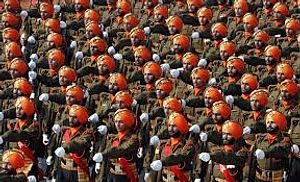India is modestly increasing its defense spending by 11 percent to around 2.47 trillion rupees ($40 billion) for the fiscal year 2015-2016 starting on April 1, according to Finance Minister Arun Jaitley’s federal budget speech last Saturday. The allocation for defense in the current fiscal year is 2.2 trillion rupees ($35 billion).
The core message in the Indian Finance Minister’s statement was the push to become less dependent on foreign military know-how and imports and to revive the Indian defense industry.
“We have been overdependent on imports, with its attendant unwelcome spin offs. We are thus pursuing the ‘Make in India policy’ to achieve greater self-sufficiency in the area of defense equipment,” Arun Jaitley stated during his speech.
India is already the world’s largest weapon’s importer (in 2013, New Delhi spent $6 billion on buying equipment), largely due to a moribund domestic defense industry. India is expected to spend $100 billion over the next decade on a defense upgrade program.
The Modi government, which made military modernization one of its top priorities, in August 2014 increased the stakes that foreign defense contractors were allowed to hold in joint defense ventures from 26 percent to 49 percent.
According to the Wall Street Journal, India only received $5 million in direct foreign investment in the defense industry over the last 14 years, in comparison to the $10 billion each that the telecommunications and automobile industries sectors were able to attract over the same period.
Whether Modi’s “Make in India” policy will be successful remains to be seen. One principal problem is that India’s arms procurement process requires offsets and technology transfers, which some Western defense contractors (notably from the United States) are not willing to do. However, there are already some encouraging signs.
In February 2015, India’s Kalyani group and Israel’s Rafael Advanced Defence Systems entered into a joint venture, the first of its kind since India raised the ceiling on foreign investors’ stakes. Kalyani will own 51 percent and Rafael 49 percent of the enterprise. “This (JV) will include a wide range of technologies and systems, like Missile Technology, Remote Weapon Systems and Advanced Armour Solutions,” a press release said.
With 1.07 trillion rupees, the biggest share of the 2015/2016 defense budget will be allocated to the army (up from 1.01 trillion in the current year). The Indian Air Force’s war chest will increase from 231 billion rupees to 243 billion rupees, whereas the navy’s budget will rise from 145 billion to 161 billion rupees. According to an analysis by the Indian Institute for Defense Analysis, around 1.05 trillion rupees will be allocated to capital and 1.45 trillion rupees to revenue expenditures. Remarkably, the Indian Defense Review notes that pensions alone will suck up 545 billion rupees — more than the Air Force’s and Navy’s budgets combined.
The magazine argues that the new defense budget is inadequate in the face of increasing geopolitical tensions:
This defense budget falls critically short in the overall endeavor of capacity building of our armed forces to cater for envisioned threat perception. The limited rise in the military budget indicates that the shopping list of 126 fighter aircraft from Dassault, 197 light helicopters, 145 Ultra-light Howitzers, 15 Apache attack helicopters and 22 CH-47F Chinook medium lift helicopters is unlikely to materialize soon… [T]hree-fourth[s] of the total allotted budget is spent on maintaining the world’s third largest standing force. This clearly implies that only a few new weapons will be ordered this year.”
This will give China even less reason to fear Indian military modernization. This Thursday, Beijing will announce its new defense budget during the first day of the annual session of the National People’s Congress (NPC). According to media reports, the PRC’s defense budget will likely be around $140 billion — more than three and a half times India’s amount, an asymmetry which has many Indian defense analysts worried (and China does not include expenditures on arms imports in their military expenditure figures). Also, China has a sizeable indigenous defense industry, which India lacks.
The response from Pakistan to India’s modest defense budget hike was predictable. According to an editorial in The News International, a paper with close ties to Pakistan’s military, the increase in defense spending was “unfortunate” since “…in recent months New Delhi has been taking an increasingly belligerent stance as far as Pakistan goes, with skirmishes taking place along the Line of Control and hostile language used again and again. (…) Against this backdrop the increase in the military budget will create a new edge of tension between the two neighbors.”

































